人教版英语六年级下册
PEP人教版小学英语六年级下册英语教案全册

4.话题:本册涵盖了日常生活、兴趣爱好、季节天气、节日活动等话题。
三、教学重点与难点
1.教学重点:
掌握本册所学词汇、短语和句型。
能够熟练运用所学知识进行日常交流。
培养学生的英语听说读写能力。
2.教学难点:
不同时态的运用。
句型的转换。
词汇的记忆与运用。
四、教学策略
1.情境教学法:通过创设情境,让学生在实际语境中学习英语,提高学生的语言运用能力。
2.任务型教学法:以任务为中心,引导学生积极参与,培养学生的自主学习能力。
3.合作学习法:鼓励学生进行小组合作,培养学生的团队协作能力。
4.个性化教学法:关注学生的个体差异,因材施教,提高学生的学习兴趣。
Unit1“Howtallareyou?”
对话示例:
K:"Wheredidyougoonvacation?"
L:"Iwenttothemountns.Itwasbeautiful!"
Unit4“Who'syourfavoriteanimal?”
重点难点使用一般现在时描述喜好。
教学过程补充:
活动一:学生制作小卡片,上面画上自己喜欢的动物,然后互相交流。
对话示例:
C:"Howtallisyourbrother?"
D:"Mybrotheris180centimeterstall."
Unit2“Whattimeisit?”
重点难点:掌握时间表达法,能够准确询问和回答时间。
教学过程补充:
活动一:利用挂钟或电子钟,教师任意调整时间,让学生用“Whattimeisit?”进行问答。
六年级下册英语单词表人教版

六年级下册英语单词表(人教版)1. Unit 1: Hobbies and Interests1.hobby - 爱好2.collect - 收集3.stamp - 邮票4.coin - 硬币5.shell - 贝壳6.postcard - 明信片7.play - 玩,进行8.games - 游戏9.chess - 国际象棋10.musician - 音乐家11.singer - 歌手12.actor - 演员13.dancer - 舞者14.painting - 绘画15.drawing - 素描16.instrument - 乐器17.guitar - 吉他18.piano - 钢琴19.violin - 小提琴20.flute - 笛子2. Unit 2: Daily Life1.daily - 日常的2.life - 生活3.wake up - 醒来4.get up - 起床5.have breakfast - 吃早餐6.brush teeth - 刷牙7.wash face - 洗脸b hair - 梳头9.get dressed - 穿衣服10.go to school - 去学校11.have lunch - 吃午餐12.do homework - 做作业13.take a shower - 洗澡14.have dinner - 吃晚餐15.watch TV - 看电视16.go to bed - 睡觉17.morning - 早上18.afternoon - 下午19.evening - 晚上20.night - 夜晚3. Unit 3: Travel and Holidays1.travel - 旅行2.holiday - 假期3.trip - 旅行4.visit - 参观5.Japan - 日本6.China - 中国A - 美国8.France - 法国9.Italy - 意大利10.Australia - 澳大利亚11.Thailand - 泰国12.beach - 海滩13.mountain - 山14.city - 城市15.countryside - 乡村16.hotel - 酒店17.plane - 飞机18.train - 火车19.bus - 公共汽车20.car - 汽车4. Unit 4: Food and Drinks1.food - 食物2.drink - 饮料3.fruit - 水果4.apple - 苹果5.banana - 香蕉6.orange - 橙子7.strawberry - 草莓8.watermelon - 西瓜9.pineapple - 菠萝10.grape - 葡萄11.vegetable - 蔬菜12.tomato - 番茄13.carrot - 胡萝卜14.cucumber - 黄瓜15.potato - 土豆16.onion - 洋葱17.chicken - 鸡肉18.beef - 牛肉19.fish - 鱼20.rice - 米饭5. Unit 5: Sports and Games1.sports - 运动2.game - 游戏3.soccer - 足球4.basketball - 篮球5.volleyball - 排球6.tennis - 网球7.table tennis - 乒乓球8.badminton - 羽毛球9.baseball - 棒球10.swimming - 游泳11.running - 跑步12.cycling - 骑自行车13.skating - 滑冰14.skiing - 滑雪15.chess - 中国象棋16.cards - 纸牌puter games - 电脑游戏18.board games - 桌游19.puzzle - 拼图20.jigsaw - 拼图游戏6. Unit 6: Occupations1.occupations - 职业2.teacher - 教师3.doctor - 医生4.nurse - 护士5.engineer - 工程师6.pilot - 飞行员7.firefighter - 消防员8.police officer - 警察9.chef - 厨师10.photographer - 摄影师11.artist - 艺术家12.writer - 作家13.journalist - 记者14.scientist - 科学家15.musician - 音乐家16.actor - 演员17.dancer - 舞者18.athlete - 运动员19.architect - 建筑师wyer - 律师以上是六年级下册英语单词表人教版的内容,包括了各个单元的重要单词。
人教pep版六年级英语下册电子课本
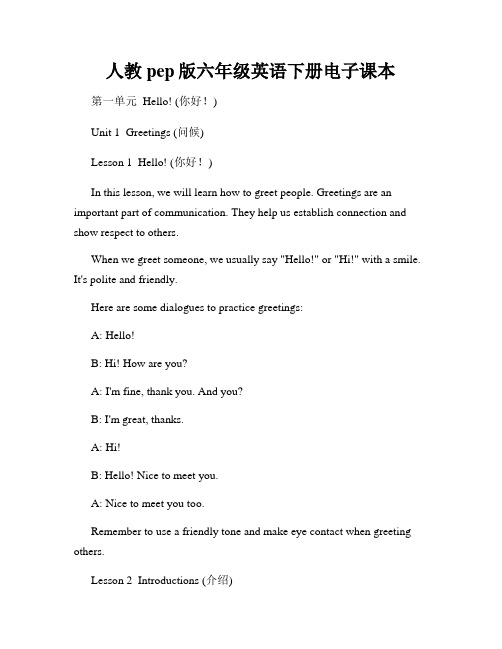
人教pep版六年级英语下册电子课本第一单元 Hello! (你好!)Unit 1 Greetings (问候)Lesson 1 Hello! (你好!)In this lesson, we will learn how to greet people. Greetings are an important part of communication. They help us establish connection and show respect to others.When we greet someone, we usually say "Hello!" or "Hi!" with a smile. It's polite and friendly.Here are some dialogues to practice greetings:A: Hello!B: Hi! How are you?A: I'm fine, thank you. And you?B: I'm great, thanks.A: Hi!B: Hello! Nice to meet you.A: Nice to meet you too.Remember to use a friendly tone and make eye contact when greeting others.Lesson 2 Introductions (介绍)In this lesson, we will learn how to introduce ourselves and others. Introductions help us get to know each other better.When introducing yourself, you can say:- My name is [Your Name].- I am [Your Age].- I am from [Your City/Country].- I like [Your Hobby].- Nice to meet you!When introducing others, you can say:- This is [Person's Name].- He/She is [Person's Age].- He/She is from [Person's City/Country].- He/She likes [Person's Hobby].- Nice to meet you!Here are some examples:A: Hello! My name is Tom.B: Hi Tom! I'm Emily.A: Nice to meet you, Emily.B: Nice to meet you too, Tom.A: This is my friend, Lisa.B: Hello Lisa! Nice to meet you.A: Nice to meet you too.Remember to speak clearly and confidently when introducing yourself and others.Lesson 3 Goodbye! (再见)In this lesson, we will learn how to say goodbye. Saying goodbye politely shows respect to others and ends the conversation politely.Here are some common ways to say goodbye:- Goodbye!- See you later!- Bye-bye!- Take care!- Have a nice day!Here are some examples:A: Goodbye!B: Goodbye! See you tomorrow.A: See you tomorrow, bye!A: Bye-bye!B: Bye-bye! Have a great day.A: Thank you, you too!Remember to wave or give a friendly smile when saying goodbye.That's all for Unit 1. Practice your greetings, introductions, and goodbyes with your friends and family. Remember to be polite and friendly. See you in the next unit!。
六年级下册英语书笔记人教版
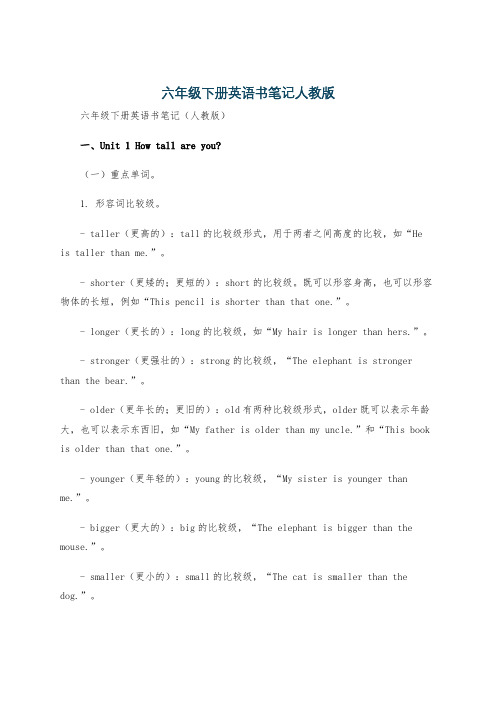
六年级下册英语书笔记人教版六年级下册英语书笔记(人教版)一、Unit 1 How tall are you?(一)重点单词。
1. 形容词比较级。
- taller(更高的):tall的比较级形式,用于两者之间高度的比较,如“He is taller than me.”。
- shorter(更矮的;更短的):short的比较级。
既可以形容身高,也可以形容物体的长短,例如“This pencil is shorter than that one.”。
- longer(更长的):long的比较级,如“My hair is longer than hers.”。
- stronger(更强壮的):strong的比较级,“The elephant is stronger than the bear.”。
- older(更年长的;更旧的):old有两种比较级形式,older既可以表示年龄大,也可以表示东西旧,如“My father is older than my uncle.”和“This book is older than that one.”。
- younger(更年轻的):young的比较级,“My sister is younger than me.”。
- bigger(更大的):big的比较级,“The elephant is bigger than the mouse.”。
- smaller(更小的):small的比较级,“The cat is smaller than the dog.”。
- thinner(更瘦的):thin的比较级,“She is thinner than her sister.”。
2. 其他重点单词。
- centimeter(厘米):长度单位,缩写为“cm”,例如“I am 150 centimeters tall.”。
- meter(米):长度单位,缩写为“m”,“The building is 50 meters high.”。
人教版六年级英语下册知识点
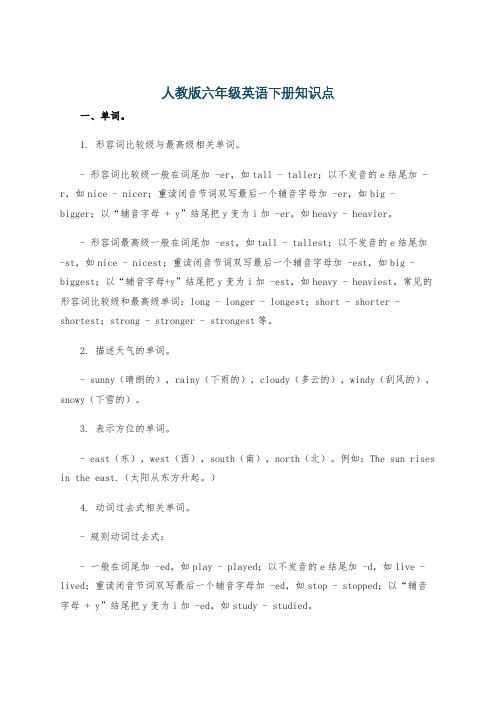
人教版六年级英语下册知识点一、单词。
1. 形容词比较级与最高级相关单词。
- 形容词比较级一般在词尾加 -er,如tall - taller;以不发音的e结尾加 -r,如nice - nicer;重读闭音节词双写最后一个辅音字母加 -er,如big - bigger;以“辅音字母 + y”结尾把y变为i加 -er,如heavy - heavier。
- 形容词最高级一般在词尾加 -est,如tall - tallest;以不发音的e结尾加-st,如nice - nicest;重读闭音节词双写最后一个辅音字母加 -est,如big - biggest;以“辅音字母+y”结尾把y变为i加 -est,如heavy - heaviest。
常见的形容词比较级和最高级单词:long - longer - longest;short - shorter - shortest;strong - stronger - strongest等。
2. 描述天气的单词。
- sunny(晴朗的),rainy(下雨的),cloudy(多云的),windy(刮风的),snowy(下雪的)。
3. 表示方位的单词。
- east(东),west(西),south(南),north(北)。
例如:The sun rises in the east.(太阳从东方升起。
)4. 动词过去式相关单词。
- 规则动词过去式:- 一般在词尾加 -ed,如play - played;以不发音的e结尾加 -d,如live - lived;重读闭音节词双写最后一个辅音字母加 -ed,如stop - stopped;以“辅音字母 + y”结尾把y变为i加 -ed,如study - studied。
- 不规则动词过去式,如go - went;come - came;do - did;have - had;see - saw等。
二、短语。
1. 描述外貌的短语。
- shorter than(比……矮),taller than(比……高),stronger than (比……强壮)。
人教版六年级下册英语知识点汇总

人教版六年级下册英语知识点汇总一、词汇1. 日常生活与社交•情感与态度词汇:happy, sad, angry, excited, surprised, worried 等。
•社交用语:invite, accept, refuse, apologize, congratulate, thank 等及其相关表达。
•节日与活动:Spring Festival, Mid-Autumn Festival, Christmas, birthday party, sports meeting 等。
2. 学校与学习•学习方法与策略:review, preview, note-taking, brainstorming 等。
•学科相关词汇:geography, history, biology, physics, chemistry(基础词汇)及学科活动。
3. 科技与未来•科技产品:computer, smartphone, internet, robot, AI 等。
•未来设想:space travel, environmental protection, renewable energy 等。
4. 旅行与交通•交通工具:plane, train, bus, subway, ship, bicycle 等。
•旅游景点与活动:museum, zoo, park, beach, hiking, camping 等。
二、语法1. 时态•熟练掌握一般现在时、一般过去时、现在进行时、一般将来时,并初步了解过去进行时和现在完成时的用法。
2. 语态•学习并理解被动语态的基本结构和用法。
3. 非谓语动词•初步接触动词不定式(to do)、动名词(doing)和分词(现在分词doing 和过去分词done)作为非谓语动词的用法。
4. 复合句•学习并列句和主从复合句(如宾语从句、状语从句、定语从句)的基本结构和用法。
三、句型与表达•能够根据语境运用多种句型进行表达,包括疑问句、祈使句、感叹句等。
(人教版)六年级下册(PEP) 英语单词表
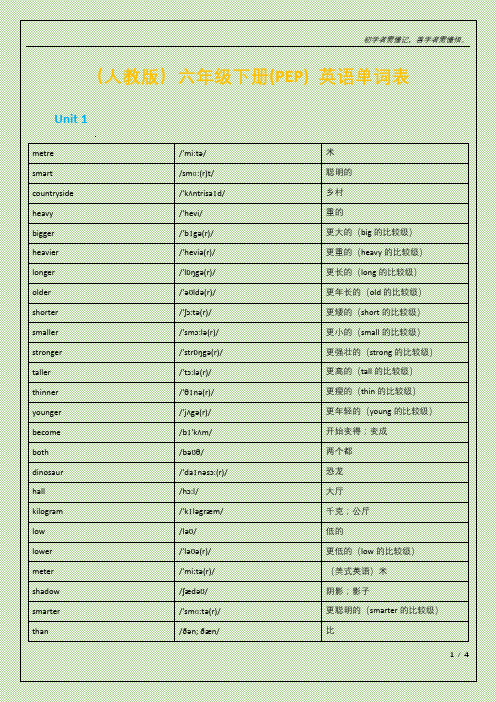
(人教版)六年级下册(PEP) 英语单词表Unit 1metre/'mi:tə/米smart/smɑ:(r)t/聪明的countryside/'kʌntrisaɪd/乡村heavy/'hevi/重的bigger/'bɪgə(r)/更大的(big的比较级)heavier/'heviə(r)/更重的(heavy的比较级)longer/'lɒŋgə(r)/更长的(long的比较级)older/'əʊldə(r)/更年长的(old的比较级)shorter/'ʃɔ:tə(r)/更矮的(short的比较级)smaller/'smɔ:lə(r)/更小的(small的比较级)stronger/'strɒŋgə(r)/更强壮的(strong的比较级)taller/'tɔ:lə(r)/更高的(tall的比较级)thinner/'θɪnə(r)/更瘦的(thin的比较级)younger/'jʌgə(r)/更年轻的(young的比较级)become/bɪ'kʌm/开始变得;变成both/bəʊθ/两个都dinosaur/'daɪnəsɔ:(r)/恐龙hall/hɔ:l/大厅kilogram/'kɪləgræm/千克;公斤low/ləʊ/低的lower/'ləʊə(r)/更低的(low的比较级)meter/'mi:tə(r)/(美式英语)米shadow/ʃædəʊ/阴影;影子smarter/'smɑ:tə(r)/更聪明的(smarter的比较级)than/ðən; ðæn/比enjoy/ɪn'dʒɔɪ/享受……乐趣;喜爱before/bɪ'fɔ:(r)/在……之前hotel/həʊ'tel/旅馆stay/steɪ/保持slept/slept/睡觉(sleep的过去式)broken/'brəʊkən/破损的read/ri:d/看;读yesterday/'jestə(r)di/昨天last/lɑ:st/, /læst/上一个的;刚过去的show/ʃəʊ/引导;指引cleaned/kli:nd/打扫(clean的过去式)had/hæd/患病;得病(have的过去式)had a cold感冒saw/sɔ:/看见(see的过去式)stayed/steɪd/停留,待(stay的过去式)washed/wɒʃt/洗(wash的过去式)watched/wɒtʃt/看(watch的过去式)better/'betə(r)/更好的(well的比较级)drank/dræŋk/喝(drink的过去式)faster/'fɑ:stə(r)/更快的(fast的比较级)fix/fɪks/修理fixed/fɪkst/修理(fix的过去式)lamp/læmp/台灯loud/laʊd/喧闹的;大声的magazine/, mægə’zi:n/, /'mægəzi:n/杂志fish/fɪʃ/鱼hurt/hɜ:(r)t/(使)受伤Labour Day/'leɪbə(r) ,deɪ/劳动节ate/eɪt/吃(eat的过去式)bought/bɔ:t/买(buy的过去式)camp/kæmp/野营gift/gɪft/礼物ride/raɪd/骑(马;自行车)rode/rəʊd/骑(ride的过去式)took/tʊk/拍照(take的过去式)took pictures照相went/went/去(go的过去式)went camping(尤指在假日)野营went fishing去钓鱼Turpan/'tʊə'pɑ:n/吐鲁番basket/'bɑ:skɪt/, /'bæskɪt/篮;筐beach/bi:tʃ/海滩;沙滩could/kʊd/能(can的过去式)fell/fel/摔倒(fall的过去式)laugh/lɑ:f/, /læf/笑laughed/lɑ:ft/笑(laugh的过去式)lick/lɪk/舔licked/lɪkt/舔(lick的过去式)mule/mju:l/骡子off/ɒf/, /ɔ:f/从(某处)落下part/pɑ:(r)t/角色till/tɪl/直到grass/grɑ:s/, /græs/草坪dream/dri:m/梦star/stɑ:(r)/星different/'dɪfərənt/不同的active/'æktɪv/积极的;活跃的badminton/'bædmɪntən/羽毛球运动race/reɪs/赛跑easy/'i:zi/容易的trip/trɪp/旅行gym/dʒɪm/体育馆ago/ə'gəʊ/以前cycling/'saɪklɪŋ/骑自行车运动(或活动)dining hall/'daɪnɪŋ ,hɔ:l/饭厅go cycling去骑自行车ice-skate/'aɪsskeɪt/滑冰Internet/'ɪntə(r)net/互联网cheetah/'tʃi:tə/猎豹felt/felt/感觉(feel的过去式)look up(在词典中或通过电脑)查阅nothing/'nʌθɪŋ/没有什么thought/θɔ:t/想(think的过去式)woke/wəʊk/醒(wake的过去式)。
新人教版pep小学六年级下册英语教案全册
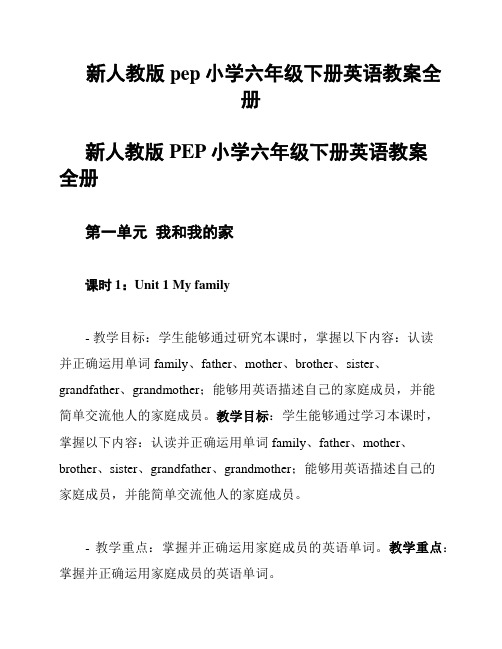
新人教版pep小学六年级下册英语教案全册新人教版PEP小学六年级下册英语教案全册第一单元我和我的家课时1:Unit 1 My family- 教学目标:学生能够通过研究本课时,掌握以下内容:认读并正确运用单词family、father、mother、brother、sister、grandfather、grandmother;能够用英语描述自己的家庭成员,并能简单交流他人的家庭成员。
教学目标:学生能够通过学习本课时,掌握以下内容:认读并正确运用单词family、father、mother、brother、sister、grandfather、grandmother;能够用英语描述自己的家庭成员,并能简单交流他人的家庭成员。
- 教学重点:掌握并正确运用家庭成员的英语单词。
教学重点:掌握并正确运用家庭成员的英语单词。
- 教学难点:用英语描述家庭成员。
教学难点:用英语描述家庭成员。
- 教学准备:PPT、单词卡片、家庭成员图片、练册。
教学准备:PPT、单词卡片、家庭成员图片、练习册。
- 教学过程:教学过程:1. 导入新课:呈现家庭成员图片,让学生说出英语单词并尽量运用在句子中。
2. 研究新知:教师通过PPT呈现单词卡片,将家庭成员单词分别与对应的图片进行呈现,学生跟读并重复。
3. 听说训练:通过描述家庭成员的图片开始练说英语。
教师提问,学生回答,并给予相应的鼓励。
4. 听力训练:播放录音,学生听录音并指认家庭成员。
5. 巩固练:练册上的相关练。
- 作业:完成练册上的相关练。
作业:完成练习册上的相关练习。
- 板书设计:板书设计:- Unit 1 My family- father- mother- brother- sister- grandfather- grandmother课时2:Unit 2 My home- 教学目标:学生能够通过研究本课时,掌握以下内容:认读并正确运用单词home、bedroom、living room、kitchen、bathroom;能够用英语描述自己的家庭住所,并能简单交流他人的家庭住所。
人教版PEP小学六年级下册英语电子课本

人教版PEP小学六年级下册英语电子课本Title: PEP Primary School Sixth Grade English Textbook。
In the sixth grade of primary school, students continue to build on their English language skills, focusing on reading, writing, listening, and speaking. The People's Education Press (PEP) English textbook for this grade is designed to help students improve their language proficiency and develop a deeper understanding of English grammar and vocabulary.The PEP English textbook covers a wide range of topics, including daily life, school, family, and hobbies. Each unit is carefully structured to provide students with a comprehensive learning experience. The textbook also includes a variety of exercises and activities to help students practice and apply their language skills in real-life situations.One of the key features of the PEP English textbook is its focus on reading comprehension. The textbook includes a variety of reading passages, including short stories, articles, and poems, to help students improve their reading skills and expand their vocabulary. The passages are carefully selected to be engaging and relevant to students' lives, making the learning experience more enjoyable and meaningful.In addition to reading, the PEP English textbook also emphasizes writing skills. Students are introduced to various types of writing, such as narratives, descriptions, and letters, and are given the opportunity to practice writing in different contexts. By engaging in writing activities, students not only improve their language skills but also develop their creativity and critical thinking abilities.Listening and speaking are also important components of the PEP English textbook. The textbook includes audio materials and speaking exercises to help students improve their listening and speaking skills. Through listening to authentic English language materials and engaging in speaking activities, students develop their ability to understand and communicate in English effectively.Furthermore, the PEP English textbook incorporates interactive activities and games to make learning more enjoyable and effective. These activities are designed to help students review and consolidate their learning in a fun and engaging way. By incorporating interactive elements, the textbook helps students stay motivated and interested in learning English.The PEP English textbook also places a strong emphasis on grammar and vocabulary. Each unit includes a variety of grammar and vocabulary exercises to help students understand and apply the rules of English language. By mastering grammar and expanding their vocabulary, students are able to express themselves more accurately and fluently in English.In conclusion, the People's Education Press (PEP) English textbook for the sixth grade of primary school is a comprehensive and engaging resource for students to improve their English language skills. By focusing on reading, writing, listening, and speaking, and incorporating interactive activities and games, the textbook provides students with a well-rounded learning experience. With its emphasis on grammar and vocabulary, the textbook helps students develop a strong foundation in English language, preparing them for further language learning and communication.。
六年级人教版英语下册单词
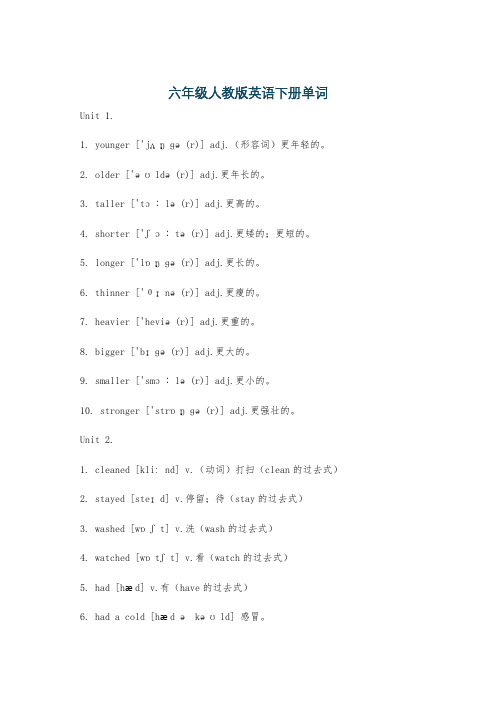
六年级人教版英语下册单词Unit 1.1. younger ['jʌŋɡə(r)] adj.(形容词)更年轻的。
2. older ['əʊldə(r)] adj.更年长的。
3. taller ['tɔːlə(r)] adj.更高的。
4. shorter ['ʃɔːtə(r)] adj.更矮的;更短的。
5. longer ['lɒŋɡə(r)] adj.更长的。
6. thinner ['θɪnə(r)] adj.更瘦的。
7. heavier ['heviə(r)] adj.更重的。
8. bigger ['bɪɡə(r)] adj.更大的。
9. smaller ['smɔːlə(r)] adj.更小的。
10. stronger ['strɒŋɡə(r)] adj.更强壮的。
Unit 2.1. cleaned [kliːnd] v.(动词)打扫(clean的过去式)2. stayed [steɪd] v.停留;待(stay的过去式)3. washed [wɒʃt] v.洗(wash的过去式)4. watched [wɒtʃt] v.看(watch的过去式)5. had [hæd] v.有(have的过去式)6. had a cold [hæd ə kəʊld] 感冒。
7. slept [slept] v.睡觉(sleep的过去式)8. read [red] v.读(read的过去式)9. saw [sɔː] v.看见(see的过去式)10. last [lɑːst] adj.最近的;上一个的;最后的。
11. yesterday ['jestədeɪ] n.(名词)昨天。
Unit 3.1. went [went] v.去(go的过去式)2. camp [kæmp] v.野营;露营;n. 野营;营地。
六年级下册英语人教版
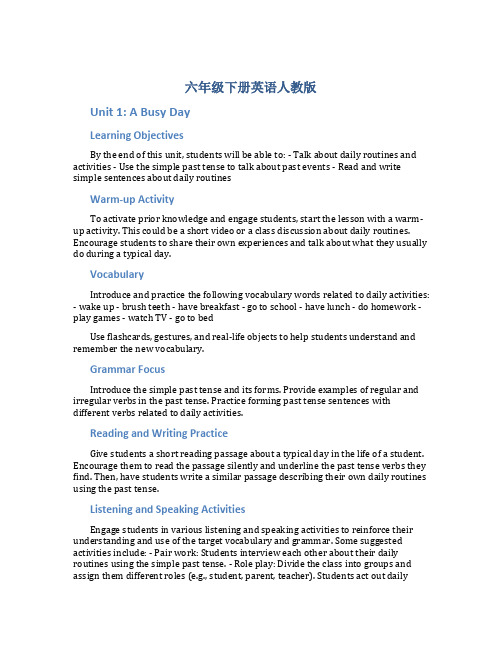
六年级下册英语人教版Unit 1: A Busy DayLearning ObjectivesBy the end of this unit, students will be able to: - Talk about daily routines and activities - Use the simple past tense to talk about past events - Read and write simple sentences about daily routinesWarm-up ActivityTo activate prior knowledge and engage students, start the lesson with a warm-up activity. This could be a short video or a class discussion about daily routines. Encourage students to share their own experiences and talk about what they usually do during a typical day.VocabularyIntroduce and practice the following vocabulary words related to daily activities: - wake up - brush teeth - have breakfast - go to school - have lunch - do homework - play games - watch TV - go to bedUse flashcards, gestures, and real-life objects to help students understand and remember the new vocabulary.Grammar FocusIntroduce the simple past tense and its forms. Provide examples of regular and irregular verbs in the past tense. Practice forming past tense sentences with different verbs related to daily activities.Reading and Writing PracticeGive students a short reading passage about a typical day in the life of a student. Encourage them to read the passage silently and underline the past tense verbs they find. Then, have students write a similar passage describing their own daily routines using the past tense.Listening and Speaking ActivitiesEngage students in various listening and speaking activities to reinforce their understanding and use of the target vocabulary and grammar. Some suggested activities include: - Pair work: Students interview each other about their daily routines using the simple past tense. - Role play: Divide the class into groups and assign them different roles (e.g., student, parent, teacher). Students act out dailyroutines using the simple past tense. - Dictation: Read out sentences describing daily activities in the past tense. Students listen and write down what they hear.AssessmentTo assess students’ understanding and progress, assign a writing task where they have to write a short paragraph about their favorite day of the week using the simple past tense. Provide a rubric to clearly outline the criteria for assessment.Extension ActivitiesFor students who need more challenge, provide extension activities to further practice and deepen their understanding. Some suggestions include: - Writing a diary entry in the simple past tense about a special event or outing. - Creating a timeline of a famous person’s life using the simple pa st tense.ConclusionThroughout this unit, students have learned how to talk about daily routines and activities using the simple past tense. They have practiced reading, writing, listening, and speaking skills to reinforce their understanding. By the end of the unit, students should be confident in using the simple past tense in their English communication.。
六年级下册英语单词表人教版

六年级下册英语单词表(人教版)第一单元:My Favorite Things名词•book: 书•pen: 钢笔•pencil: 铅笔•eraser: 橡皮擦•ruler: 尺子•bag: 书包动词•read: 读•write: 写•draw: 画•listen: 听形容词•big: 大•small: 小•blue: 蓝色•red: 红色•green: 绿色•black: 黑色•white: 白色第二单元:I Like Sports名词•ball: 球•basketball: 篮球•football: 足球•tennis: 网球•swimming: 游泳•volleyball: 排球动词•play: 玩•run: 跑•swim: 游泳•jump: 跳跃•kick: 踢•catch: 抓住形容词•fast: 快•slow: 慢•strong: 强壮•weak: 弱•good: 好•bad: 坏•fun: 有趣的第三单元:A Busy Week名词•Monday: 星期一•Tuesday: 星期二•Wednesday: 星期三•Thursday: 星期四•Friday: 星期五•Saturday: 星期六•Sunday: 星期日动词•go: 去•have: 拥有,有•eat: 吃•play: 玩形容词•busy: 忙碌的•tired: 疲倦的•happy: 快乐的•sad: 伤心的•excited: 兴奋的•angry: 生气的•rested: 精力充沛的第四单元:Let’s Learn English名词•alphabet: 字母表•letter: 字母•word: 单词•sentence: 句子•conversation: 对话•dictionary: 字典动词•spell: 拼写•learn: 学习•speak: 说•listen: 听•understand: 理解•practice: 练习形容词•easy: 容易的•difficult: 困难的•interesting: 有趣的•boring: 无聊的•useful: 有用的•important: 重要的第五单元:In the Forest名词•forest: 森林•tree: 树•flower: 花•grass: 草•river: 河流•animal: 动物动词•walk: 散步•run: 奔跑•swim: 游泳•fly: 飞•jump: 跳跃•sing: 唱歌形容词•beautiful: 美丽的•colorful: 多彩的•quiet: 安静的•noisy: 吵闹的•sunny: 晴朗的•cloudy: 多云的•rainy: 下雨的第六单元:Going Shopping名词•store: 商店•market: 市场•shop: 店铺•supermarket: 超市•toy: 玩具•snack: 小吃动词•buy: 购买•sell: 出售•pay: 付款•try: 尝试•choose: 选择•want: 想要形容词•cheap: 便宜的•expensive: 昂贵的•delicious: 美味的•sweet: 甜的•sour: 酸的•fresh: 新鲜的•stale: 陈旧的以上是六年级下册英语单词表的总结,包括了各单元的名词、动词和形容词。
小学英语(pep)人教版六年级(下册)课文及课文翻译
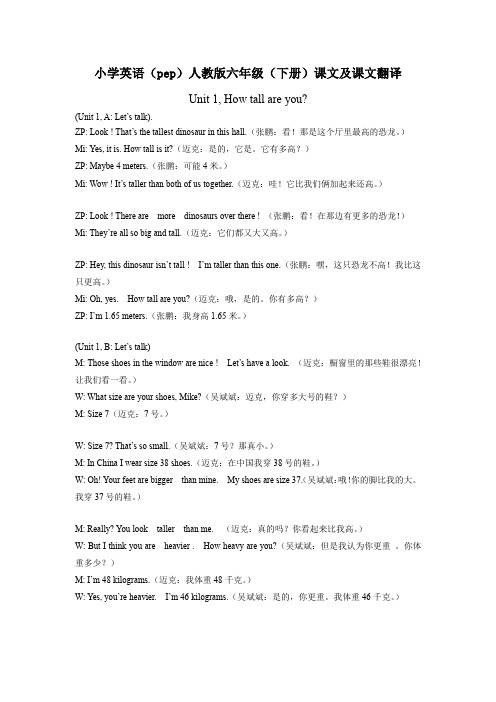
小学英语(pep)人教版六年级(下册)课文及课文翻译Unit 1, How tall are you?(Unit 1, A: Let’s talk).ZP: Look ! That’s the tallest dinosaur in this hall.(张鹏:看!那是这个厅里最高的恐龙。
)Mi: Yes, it is. How tall is it?(迈克:是的,它是。
它有多高?)ZP: Maybe 4 meters.(张鹏:可能4米。
)Mi: Wow ! It’s taller than both of us together.(迈克:哇!它比我们俩加起来还高。
)ZP: Look ! There are more dinosaurs over there ! (张鹏:看!在那边有更多的恐龙!)Mi: They’re all so big and tall.(迈克:它们都又大又高。
)ZP: Hey, this dinosaur isn’t tall ! I’m taller than this one.(张鹏:嘿,这只恐龙不高!我比这只更高。
)Mi: Oh, yes. How tall are you?(迈克:哦,是的。
你有多高?)ZP: I’m 1.65 meters.(张鹏:我身高1.65米。
)(Unit 1, B: Let’s talk)M: Those shoes in the window are nice ! Let’s have a look. (迈克:橱窗里的那些鞋很漂亮!让我们看一看。
)W: What size are your shoes, Mike?(吴斌斌:迈克,你穿多大号的鞋?)M: Size 7(迈克:7号。
)W: Size 7? That’s so small.(吴斌斌:7号?那真小。
)M: In China I wear size 38 shoes.(迈克:在中国我穿38号的鞋。
六年级英语下册单词表 人教版

六年级英语下册单词表人教版Unit 1.younger /'jʌŋɡə(r)/ adj. 更年轻的。
older /'əʊldə(r)/ adj. 更年长的。
taller /'tɔːlə(r)/ adj. 更高的。
shorter /'ʃɔːtə(r)/ adj. 更矮的;更短的。
longer /'lɒŋɡə(r)/ adj. 更长的。
thinner /'θɪnə(r)/ adj. 更瘦的。
heavier /'heviə(r)/ adj. 更重的。
bigger /'bɪɡə(r)/ adj. 更大的。
smaller /'smɔːlə(r)/ adj. 更小的。
stronger /'strɒŋɡə(r)/ adj. 更强壮的。
Unit 2.cleaned /kliːnd/ v. (clean 的过去式)打扫。
stayed /steɪd/ v. (stay 的过去式)停留;待。
washed /wɒʃt/ v. (wash 的过去式)洗。
watched /wɒtʃt/ v. (watch 的过去式)看。
had /hæd/ v. (have 的过去式)患病;得病。
had a cold 感冒。
slept /slept/ v. (sleep 的过去式)睡觉。
read /red/ v. (read 的过去式)读。
saw /sɔː/ v. (see 的过去式)看见。
last /lɑːst/ adj. 最近的;上一个的。
yesterday /'jestədeɪ/ n. 昨天。
before /bɪ'fɔː(r)/ prep. 在……之前。
Unit 3.went /went/ v. (go 的过去式)去。
camp /kæmp/ n. 野营。
went camping (尤指在假日)野营。
fish /fɪʃ/ v. 钓鱼;捕鱼。
六年级下册英语人教版1~3单元重点
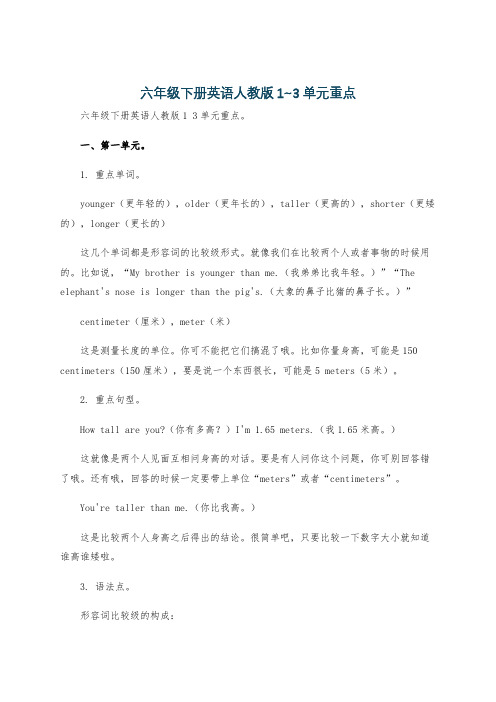
六年级下册英语人教版1~3单元重点六年级下册英语人教版1 3单元重点。
一、第一单元。
1. 重点单词。
younger(更年轻的),older(更年长的),taller(更高的),shorter(更矮的),longer(更长的)这几个单词都是形容词的比较级形式。
就像我们在比较两个人或者事物的时候用的。
比如说,“My brother is younger than me.(我弟弟比我年轻。
)”“The elephant's nose is longer than the pig's.(大象的鼻子比猪的鼻子长。
)”centimeter(厘米),meter(米)这是测量长度的单位。
你可不能把它们搞混了哦。
比如你量身高,可能是150 centimeters(150厘米),要是说一个东西很长,可能是5 meters(5米)。
2. 重点句型。
How tall are you?(你有多高?)I'm 1.65 meters.(我1.65米高。
)这就像是两个人见面互相问身高的对话。
要是有人问你这个问题,你可别回答错了哦。
还有哦,回答的时候一定要带上单位“meters”或者“centimeters”。
You're taller than me.(你比我高。
)这是比较两个人身高之后得出的结论。
很简单吧,只要比较一下数字大小就知道谁高谁矮啦。
3. 语法点。
形容词比较级的构成:一般情况下,在形容词后面加“er”,像“tall taller”“short shorter”。
以不发音的“e”结尾的形容词,直接加“r”,例如“nice nicer”。
重读闭音节,双写末尾的辅音字母,再加“er”,像“big bigger”。
还有些不规则的比较级,像“good/well better”“bad worse”。
这就像是英语里的小调皮,得特殊记忆。
二、第二单元。
1. 重点单词。
had(have的过去式),slept(sleep的过去式),read(read的过去式,读音不同哦,这里读[red]),saw(see的过去式),last(上一个的;最后的),yesterday(昨天)这些过去式可重要啦。
六年级下册英语单词表人教版
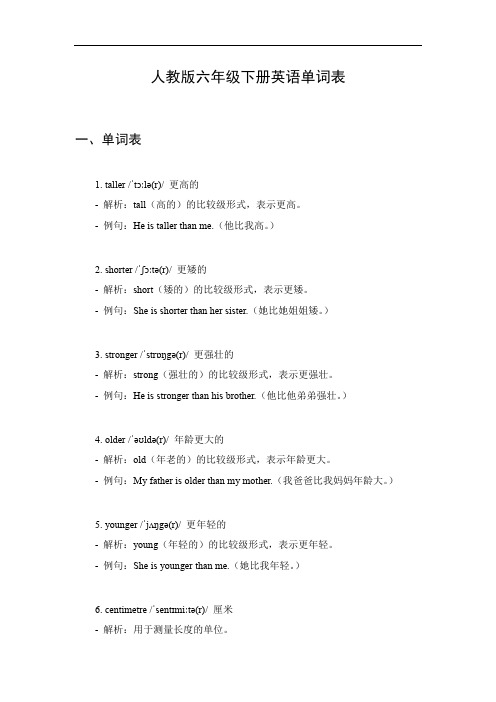
人教版六年级下册英语单词表一、单词表1. taller /ˈtɔːlə(r)/ 更高的-解析:tall(高的)的比较级形式,表示更高。
-例句:He is taller than me.(他比我高。
)2. shorter /ˈʃɔːtə(r)/ 更矮的-解析:short(矮的)的比较级形式,表示更矮。
-例句:She is shorter than her sister.(她比她姐姐矮。
)3. stronger /ˈstrɒŋgə(r)/ 更强壮的-解析:strong(强壮的)的比较级形式,表示更强壮。
-例句:He is stronger than his brother.(他比他弟弟强壮。
)4. older /ˈəʊldə(r)/ 年龄更大的-解析:old(年老的)的比较级形式,表示年龄更大。
-例句:My father is older than my mother.(我爸爸比我妈妈年龄大。
)5. younger /ˈjʌŋgə(r)/ 更年轻的-解析:young(年轻的)的比较级形式,表示更年轻。
-例句:She is younger than me.(她比我年轻。
)6. centimetre /ˈsentɪmiːtə(r)/ 厘米-解析:用于测量长度的单位。
-例句:He is 160 centimetres tall.(他身高160 厘米。
)7. kilogram /ˈkɪləɡræm/ 千克;公斤-解析:用于测量重量的单位。
-例句:The apple weighs 0.5 kilogram.(这个苹果重0.5 千克。
)8. thinner /ˈθɪnə(r)/ 更瘦的-解析:thin(瘦的)的比较级形式,表示更瘦。
-例句:She is thinner than before.(她比以前更瘦了。
)9. heavier /ˈheviə(r)/ 更重的-解析:heavy(重的)的比较级形式,表示更重。
人教版小学六年级英语下册教案5篇

人教版小学六年级英语下册教案5篇人教版小学六年级英语下册教案5篇英语教案设计是改善课堂教学的一种更高层次的探索,是提高课堂教学质量和效率的一项必要工作,它可以促进教学的系统化,使老师掌握讲课节奏。
下面小编给大家带来关于人教版小学六年级英语下册教案,方便大家学习人教版小学六年级英语下册教案1教学重点能听、说、读、写单词:in, on, under, behind, near。
能够听说认读单词:over, in front of和句子“Where is …It’s ….”,并能在一定情景中正确运用。
教学难点熟练掌握七个方位介词的用法,特别是“in front of”。
课前准备1.教师准备教学过程中所需要的图片、声音和课件。
2.教师准备录音机及录音带。
教学过程Warm—up(热身)(1)唱一唱① 教师播放歌曲“I am a boy and you are a girl.”两遍,学生小声跟唱。
② 教师领读歌词后,学生大声跟唱,并鼓励学生加些动作。
Presentation(新课呈现)⑴ 学一学① 教师出示图中“in”的图,问学生:“Where is the ball”,领读“in”。
② 教师请学生用“in”说一说他们的铅笔在哪里。
学生可以把铅笔放在任意一样东西的里面说,如:It’s in the pencil-box. It’s in the desk.It’s in my hand.等等。
③ 用同样的方法学习“on”和“under”,强调字母O和U在单词中的发音。
④ 教师分别给出“behind, near, over, in front of”四个单词及其图片。
教师边读边把图放到相应的单词旁,让学生理解其意,也加深印象。
⑤ 教师提问学生:“Where is the pencil”,学生这回可以把铅笔放在任意一地,回答道:“My pencil is on the chair. It’s in front of the pencil-case”等等。
人教版pep六年级英语下册【全册全套】课件

人教版pep六年级英语下册【全册全套】课件一、教学内容1. Unit 1 How tall are you?知识点:询问身高、体重,描述外貌特征。
2. Unit 2 Last weekend知识点:过去式动词,描述过去发生的事情。
3. Unit 3 Where did you go?知识点:过去式动词,询问旅游地点及活动。
4. Unit 4 Then and now知识点:过去式与现在式的对比,描述成长变化。
二、教学目标1. 掌握并运用本册书中的重点词汇和句型,进行日常交流。
2. 能够用过去式描述过去发生的事情,了解并运用一般过去时态。
三、教学难点与重点1. 教学难点:一般过去时态的运用,描述外貌特征。
2. 教学重点:重点词汇、短语和句型的掌握,提高听说读写能力。
四、教具与学具准备1. 教具:PPT课件、实物、图片、录音机、磁带。
2. 学具:英语课本、练习册、文具、卡片。
五、教学过程1. 导入:通过图片、歌曲或小故事引入实践情景,激发学生兴趣。
2. 新课内容展示:讲解重点词汇、短语和句型,结合实际案例进行教学。
3. 例题讲解:针对难点,设计典型例题,详细讲解。
4. 随堂练习:让学生进行小组讨论、角色扮演等,巩固所学内容。
六、板书设计1. 人教版PEP六年级英语下册全套课件2. 内容:各单元重点词汇、短语、句型,用不同颜色粉笔进行区分。
七、作业设计1. 作业题目:写一篇关于自己的身高、体重和外貌的短文。
描述一下你上周的周末活动。
写一篇关于你最近一次旅行的短文。
与同学互相采访,询问彼此小时候和现在的变化,整理成对话。
答案:见附件。
八、课后反思及拓展延伸2. 拓展延伸:鼓励学生进行课外阅读,观看英语动画片,提高英语实际运用能力。
组织英语角活动,让学生在真实语境中练习英语。
重点和难点解析1. 教学内容的章节和详细内容2. 教学目标的具体化3. 教学难点与重点的区分4. 教学过程中的实践情景引入、例题讲解和随堂练习5. 板书设计的逻辑性和直观性6. 作业设计的针对性和答案的详细性7. 课后反思及拓展延伸的实际操作一、教学内容的章节和详细内容重点关注各单元的知识点,确保每个知识点都有明确的讲解和练习。
- 1、下载文档前请自行甄别文档内容的完整性,平台不提供额外的编辑、内容补充、找答案等附加服务。
- 2、"仅部分预览"的文档,不可在线预览部分如存在完整性等问题,可反馈申请退款(可完整预览的文档不适用该条件!)。
- 3、如文档侵犯您的权益,请联系客服反馈,我们会尽快为您处理(人工客服工作时间:9:00-18:30)。
人教版英语六年级下册牛津小学英语6B教案—Unit 3 Asking the way 第一课时一、教学内容:6B. Unit 3 A部分,Listen ,read and say.二、教学目标:1 初步掌握理解课文,并能在交际中口头运用关于问路的句型2 掌握四会单词. stops, turn left /right , post office ,get on /off, along, street。
3 掌握三会单词和词组. city, crossing, away, shopping center , .middle school , out of ,train station ,History Museum .4 能听懂会说句型和日常交际用语Go along this street, and then turn right at the thirdcrossing . How far is it from here It's about a kilometer away .You can take bus No. 5 .How many stops are there How can I get to the shopping center?5 四会句型:Can you tell me the way to ...,please .三、教学重、难点:能正确理解、掌握四会单词和句型。
四、课前准备:1 准备录音机和本课A部分的磁带。
2 准备A部分的图片。
3 课前写好本课的课题6B. Unit 3A部分Look, read and say五、教学过程:A Sing a song. 跟录音机边听边表演唱英文歌曲HelloB Free talk. 师生交流T: Good morning, boys and girls.Ss: Good morning,T: Nice to see you again.Ss: Nice to see you, too.T: Do you run fast Do you run faster than xxx?Do you jump high Do you jump higher than xxx?Do you swim fast Does he swim faster than David ?T: Where is you school Where is the xxx?C Presentation and drill新授和操练1 教师通过刚才的师生问答用旧知识引出句型Can you tell me the way to the xxx Go along thisstreet ,and then turn right at the third crossing .2 教师板书句型中出现的生词进行教学同时让学生理解。
3 教师出示音标让学生试读,然后集体升降调朗读。
4 教师假装着急:How far is it from here It's about kilometer away..同时板书单词,运用相同的方法学习单词,同时领读句子。
5 就刚才创设情景,T:How many stops are there引出every 5minutes ,get off at the third stop的学习。
同时让学生模仿说几句。
6 教师板书句型并领读。
D Practice and consolidation练习和巩固1 让学生听录音,引出单词和词组History Museum ,post office的学习。
2 T板书以上单词和词组学生集体朗读,并扩展出词组和句子3 让学生模仿跟读录音。
4 学生小组活动,每人接龙说一个问路的句子Can you tell me the way to ...?5 在次基础上小组讨论说出句型的回答:go along this street ,and turn right at the thirdcrossing ......6 请学生用老师提供的地点运用句型,接龙说句子。
7 Ask and answer in pairs.。
六布置作业:听本课A部分的录音,要求学生跟读、读熟。
找资料说出一些中国地名和外国地名。
七、板书设计Unit 3 Asking the waystops turn left /right , post office ,get on /off, along, streetCan you tell me the way to ...,please八、教后记:牛津小学英语6B教案——Unit 3 Asking the way 第二课时一、教学内容:6B. Unit 3B部分Look ,Read and learn二、教学目标:1 能正确理解、掌握A部分会话,并能朗读、初步表演对话。
2 能正确地运用对话中出现的日常交际用语交流。
3 正确掌握B部分出现的四会单词post office,get on, get off,和Can you tell me the way to...?以及回答的四会句型4.掌握B部分中出现的三会单词middle school, train station, shopping center, History Museum .三、教学重、难点:能正确理解、掌握B部分单词。
能熟练运用巨型操练单词。
四、课前准备:1 准备录音机和磁带。
2 准备本课单词的图片。
3 准备好的调查内容。
4 课前写好本课的课题。
五、教学过程:A Sing a song. 跟录音机边听边表演唱英文歌曲HelloB Free talk. 师生交流T: Good morning, boys and girls.Ss: Good morning,T: Nice to see you again.Ss: Nice to see you, too.T: What day is it today?Ss: It's Monday.T: Are you as tall as xxx?T: Who is taller ,you or TomT: Who is younger ,you or Su Yang ?S3: I'm younger than Su Yang .T:Do the boys run faster than the girls?Doyou jump higher than xxx?Do you swim faster than xxx?T: Can you tell me the way to you r school?...C Presentation and drill新授和操练T和学生的对话引出B部分单词的教学。
T: Can you tell me the way to ...引出同类单词的教学。
教师板书middle school, train station, shopping center, HistoryMuseum .,让学生静听,后模仿、跟读。
1 教师继续创设情景用句型引出单词并引导学生说句子。
T:Go along this street and turn right at the third crossing..教师板书句子.让学生静听模仿跟读。
然后集体升降调朗读。
2 运用刚才所学句子出示图片操练。
让2个学生做动作大家一起说Ss: Can you tell me the way to ...?Go along this street and trun right at the third crossing ...3 运用刚才所学句型和单词小组内学生进行交流。
4 小组内学生汇报刚才所说的句型,分组进行,看哪组学生说的又流利、又正确。
5 Talk in pairs then ask and answer.D Practice and consolidation练习和巩固1 让学生听录音,模仿跟读单词。
2 游戏:A:一学生说地名他的同桌说出问路的句子。
B:分集团接龙说表示地名单词。
3 再次让学生听录音,模仿跟读单词。
在学生跟读中,纠正学生朗读中出现的错误。
4 在学生能正确朗读的基础上让学生用外国地名问路。
六布置作业:1朗读课文和B部分单词。
2 表演问路。
七、板书:Unit 3 Asking the waypost office,get on, get offCan you tell me the way to...?Go along this way then turn right at the third crossing.牛津小学英语6B教案——Unit 3 Asking the way 第三课时一、教学内容:6B. Unit 3C部分Look and say.二、教学目标:1 掌握日常交际用语的正确用法。
2 熟练掌握四会单词的运用.3 熟练运用四会句型:Can you tell me the way to …,please三、教学重、难点:1 能正确理解、掌握四会单词stops, turn left /right , post office ,get on /off, along, street。
2 并能熟练运用四会句型和日常交际用语: Go along this street, and then turnright at the third crossing 。
The …is on your…. How far is it from here It’s about a kilometer away .You can take bus No. 5 . Howmany stops are there How can I get to the shopping center四、课前准备:1 准备录音机和本课C部分的投影片。
2 课前写好本课的课题。
五、教学过程:A Sing a song. 跟录音机边听边表演唱英文歌曲B Free talk. 师生交流T: Good morning, boys and girls.Ss: Good morning,T: Nice to see you again.Ss: Nice to see you, too.T: What day is it todaySs: It’s Monday.T: Are you as tall as xxxT: Who is taller ,you or TomT: Who is younger ,you or Su YangS: I’m younger than Su Yang .T: Do you run faster than xxxDo you jump higher than xxxDo you swim faster than xxxT: Can you tell me the way to …C Revision复习会话1 看A部分投影片,师生问答,讨论会话。
